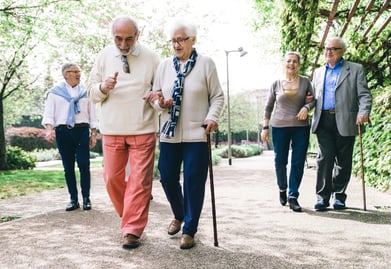One answer could be to simply modify existing programs to better fit the assisted living population. This way, managers save some time with planning and can use many of the same program materials (which means saving money, too).
Here are a variety of tips for modifying senior fitness programs for assisted living:
1. Make it a team effort.
One of the simplest ways to change an incentive program is to take it from an individual effort challenge to a team goal. For example, if the goal of the program in IL is to have a resident achieve 15 group fitness class visits over the course of a month, maybe the goal for AL would be to have the entire group achieve 35 group fitness classes over the month. Obviously, the goal numbers will depend on availability of classes and residents who want to participate, but you get the idea. Take it one step further and create a tracking poster to keep in the assisted living fitness area so residents can keep up on their progress.
2. Get volunteers involved.
Another way to make sure your assisted living program is successful is to involve some volunteers. Let’s say you’re doing a one-mile walking event for IL and you want to run the same event in assisted living. For IL, you can probably just market the event, promise some water and granola bars at the “finish line,” and residents will come out to participate. You could try the same thing in AL, but it certainly wouldn’t go over as well.
Instead, try recruiting volunteers (either staff or residents) and pair up with people while they walk. This way, your walk becomes not only about physical health, but also about social wellness and emotional wellness. Plus, most people would think of this event as an activity rather than just exercise, and so they are more likely to attend.
3. Recognize participants.
This isn’t actually a modification because it works equally well in both levels of care, but it’s still a great way to make the program a success. People love a recognition for their work. In assisted living, this can mean getting a little creative. Yes, you can stick with the typical throw-a-party-for-participants-at-the-end-of-the-program reward. Or you can try something a little different.
One of the simplest but most effective examples of this was during our Fitness Freeze last year. During this program, residents earn snowflakes for visits during the month of December. Instead of hanging them in the fitness center, one manager hung the snowflakes earned by assisted living residents on their doors. This resulted in two major positives:
- When family and friends visited, residents could brag about their fitness center participation.
- It brought more attention to the program and other residents started asking about how they could earn snowflakes.
***


